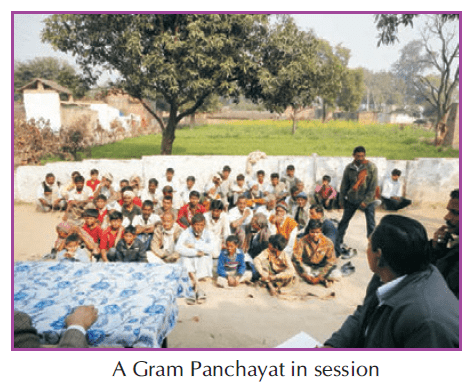Indian Villages Class 3 Notes SST
| Table of contents |

|
| GRAM PANCHAYAT |

|
| FUNCTIONS OF THE GRAM PANCHAYAT |

|
| INCOME OF THE PANCHAYAT |

|
| PARTS OF THE RURAL GOVERNMENT |

|
A large part of the Indian population lives in villages. The life of the people living in a village is different from that of the people living in towns and cities.

GRAM PANCHAYAT
A village is like a family. There has to be someone to look after the needs of the people living in a family. But when the family is big, one head cannot look after all its needs. So, in a village, we have more than one head to look after the needs of the people. In a village, these heads are called Panches. Panches are the members who conduct the village Panchayat.
GO FACT : There are around six lakh villages in India.
A village panchayat or gram panchayat governs the village. It is an elected body. All the panches are elected by the villagers. Each village panchayat has at least one woman member. The head of the panches is called the Pradhan or the Sarpanch.
FUNCTIONS OF THE GRAM PANCHAYAT
The village panchayat looks after the needs of the villagers. It takes various steps for the improvement of the village. Some of these are:
1. To settle disputes among villagers.
2. To supply clean drinking water.
3. To maintain cleanliness in the village.
4. To administer schools for the village children.
5. To establish night schools for the education of adults.
6. To construct and repair village streets and roads.
7. To make arrangement for civic amenities for the people.
8. To set up dispensaries and medical camps.

INCOME OF THE PANCHAYAT
The village panchayat needs money to do all the welfare activities. It gets money from the taxes that people pay for using roads, houses, land, electricity and water. It also gets money from the State Government as grant-in-aid.
But the efforts of the Gram Panchayat are not enough to fulfil the needs of the people. It is also the duty of every villager to keep the surroundings clean and take care of the public property.
The government appoints trained individuals (both men and women) to advise the farmers about new methods of farming. They give important information about crops, seeds, means of irrigation, etc. These people are called gram sevaks (men) and gram sevikas (women).
PARTS OF THE RURAL GOVERNMENT
Many villages are joined together to form a block. Each block is managed by a block samiti. There are many block samitis at the district level. The zila (district) parishad looks after the needs of the whole district. The panchayat, the block samiti and the zila parishad are the three main parts of the rural government.
KEYWORDS
Gram panchayat: local government at the village or small town level in India.
Governs: to make and administer the public policy and affairs.
Sarpanch/Pradhan: the head of gram panchayat.
Civic amenities: the facilities provided by the government for common people.
SUMMARY
- Every village has a local governing body called the village panchayat or Gram Panchayat.
- The head of gram panchayat is called Pradhan or Sarpanch.
- The villagers elect the members of a village panchayat.
- The Gram Panchayat works for the progress of the village and its people.
|
15 videos|85 docs|22 tests
|
FAQs on Indian Villages Class 3 Notes SST
| 1. What is the role of a Gram Panchayat? |  |
| 2. What are the functions of a Gram Panchayat? |  |
| 3. How does a Gram Panchayat generate income? |  |
| 4. What are the major components of the rural government in India? |  |
| 5. How does a Gram Panchayat contribute to the development of Indian villages? |  |















